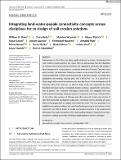| dc.contributor.author | Blake, William | |
| dc.contributor.author | Kelly, Claire | |
| dc.contributor.author | Wynants, Maarten | |
| dc.contributor.author | Patrick, Aloyce | |
| dc.contributor.author | Lewin, Shaun | |
| dc.contributor.author | Lawson, Joseph | |
| dc.contributor.author | Nasolwa, Emmanuel | |
| dc.contributor.author | Page, Annabel | |
| dc.contributor.author | Nasseri, Mona | |
| dc.contributor.author | Marks, Carey | |
| dc.contributor.author | Gilvear, David | |
| dc.contributor.author | Mtei, Kelvin | |
| dc.contributor.author | Munishi, Linus | |
| dc.contributor.author | Ndakidemi, Patrick | |
| dc.date.accessioned | 2023-10-10T09:51:27Z | |
| dc.date.available | 2023-10-10T09:51:27Z | |
| dc.date.issued | 2020-10-02 | |
| dc.identifier.uri | https://doi.org/10.1002/ldr.3791 | |
| dc.identifier.uri | https://dspace.nm-aist.ac.tz/handle/20.500.12479/2227 | |
| dc.description | This research article was published in the Land Degradation & Development Volume 32, Issue 12, 2020 | en_US |
| dc.description.abstract | Soil resources in East Africa are being rapidly depleted by erosion, threatening food, water and livelihood security in the region. Here we demonstrate how the integration of evidence from natural and social sciences has supported a community-led change in land management in an agro-pastoral community in northern Tanzania. Geospatial analysis of erosion risk and extent (based on a drone survey across a 3.6 km2 sub-catchment) revealed that recently converted land had ca 12-times greater rill density than established slow-forming terraced plots (987 ± 840 m2 ha−1 vs. 79 ± 110 m2 ha−1). Slope length and connectivity between plots were key factors in the development of rill networks rather than slope per se wherein slope length was augmented by weak boundaries between newly formed plots. Erosion evidence, supported by communication of 'process' and 'structural' hydrological connectivity, was integrated with local environmental knowledge within participatory community workshops. Demonstration of the critical time window of hillslope-scale rill erosion risk during early phases of slow-forming terrace development catalysed a community-led tree planting and grass seed sowing programme to mitigate soil erosion by water. This was grounded in an implicit farmer understanding of the need for effective governance mechanisms at both community and District levels, to enable community-led actions to be implemented effectively. The study demonstrates the wide-reaching impact of integrated and interdisciplinary 'upslope-downslope' thinking to tackle global soil erosion challenges. | en_US |
| dc.language.iso | en | en_US |
| dc.publisher | John Wiley & Sons, Inc. | en_US |
| dc.subject | Agro-pastoral | en_US |
| dc.subject | Drought | en_US |
| dc.subject | Erosion | en_US |
| dc.subject | Land degradation | en_US |
| dc.title | Integrating land-water-people connectivity concepts across disciplines for co-design of soil erosion solutions | en_US |
| dc.type | Article | en_US |

